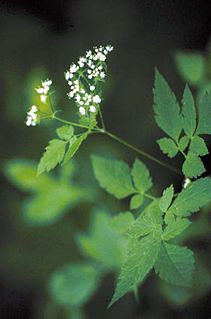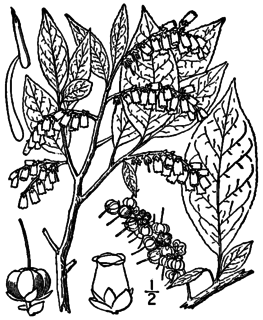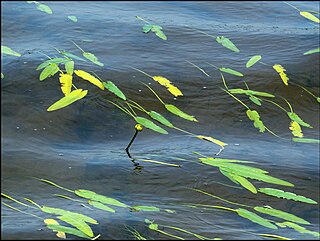
Osmorhiza claytonii is a North American perennial herb, native to Canada and the eastern United States. It is also known as Clayton's sweetroot or sweet cicely, a name it shares with other members of its genus Osmorhiza.

Iris lacustris, the dwarf lake iris, is a plant species in the genus Iris, subgenus Limniris and in the section Lophiris. It is a rhizomatous, beardless perennial plant, native to the Great Lakes region of eastern North America. It has lavender blue or violet-blue flowers, a very short stem and long fan-like green leaves. It is cultivated as an ornamental plant in temperate regions. It is closely related to Iris cristata.

Iris cristata is a species in the genus Iris, it is also in the subgenus of Limniris. It is a rhizomatous perennial plant, endemic to the eastern United States. It has pale lavender flowers with a white patch and orange or yellow crest. It is a close relative to Iris lacustris, the only other crested iris native to North America. It is cultivated as an ornamental plant in temperate regions.

Allium cernuum, known as nodding onion or lady's leek, is a perennial plant in the genus Allium. It grows in dry woods, rock outcroppings, and prairies. It has been reported from much of the United States, Canada and Mexico including in the Appalachian Mountains from Alabama to New York State, the Great Lakes Region, the Ohio and Tennessee River Valleys, the Ozarks of Arkansas and Missouri, and the Rocky and Cascade Mountains of the West, from Mexico to Washington. It has not been reported from California, Nevada, Florida, Louisiana, Mississippi, New Jersey, Delaware, New England, or much of the Great Plains. In Canada, it grows from Ontario to British Columbia.

Goodyera oblongifolia is a species of orchid known by the common names western rattlesnake plantain and giant rattlesnake plantain. It is native to much of North America, particularly in the mountains of the western United States and Canada, from Alaska to northern Mexico, as well as in the Great Lakes region, Maine, Quebec and the Canadian Maritime Provinces.

Silene ovata, the Blue Ridge catchfly or ovate-leaved catchfly, is a herbaceous plant in the family Caryophyllaceae. This perennial plant grows up to 1.5 m tall and has large opposite leaves without petioles which are 5–12 cm long and taper to a long point, 2–5 cm wide and numerous finely fringed white flowers with a tube.
Vaccinium boreale, common name northern blueberry, sweet hurts or bleuet boréal, is a plant species native to the northeastern United States and eastern Canada. It has been reported from Québec, New Brunswick, Nova Scotia, Newfoundland & Labrador, Maine, New Hampshire, Vermont, and New York State. It grows in tundra, rocky uplands and in open conifer forests at elevations up to 2000 m.

Eubotrys recurva is a plant species native to the eastern United States. Common names include deciduous mountain fetterbush and red-twig doghobble. The plant grows in moist forests, bogs, granitic domes, etc., at elevations up to 1500 m. It has been reported from Alabama, Georgia, North and South Carolina, Tennessee, Kentucky, Ohio, Virginia, West Virginia and New York State.

Solidago puberula, the downy goldenrod, is a plant species native to eastern North America from Nova Scotia and Ontario south to Florida and Louisiana. Two subspecies are commonly recognized:
Parietaria floridana, common name Florida pellitory, is a plant species native to the southeastern United States, the West Indies, and much of Latin America. In the US, the heart of its range extends from Florida, to Georgia and North and South Carolina, with isolated populations reported in Mississippi, Louisiana, Texas, New Hampshire, Kentucky and Delaware. Some populations in California have in the past been referred to as P. floridana but are now regarded as a separate species, P. hespera.
Paronychia argyrocoma, the silvery nailwort, is a plant species native to the eastern United States. It has a disjunct distribution, found in New England and the Appalachian Mountains of the Southeast but not from New York, New Jersey or Pennsylvania in between. The species grows on rocky sites at elevations of 200–1800 m.
Juncus megacephalus, the bighead rush, is a plant species native to the United States. It is known from every seacoast state from Texas to Maryland, as well as Massachusetts, growing in freshwater marshes, sand dunes, and disturbed sites at elevations less than 100 m.
Eleocharis tuberculosa, the cone-cup spikerush, is a plant species native to the United States and Canada. It has been reported from every state on the Gulf and Atlantic coasts from Maine to Texas, plus Kentucky, Tennessee, Arkansas and Nova Scotia. It is found in wet soil in meadows, woodlands, lake shores and river banks.

Aletris farinosa, called the unicorn root, true unicorn, crow-corn, white colic-root or white stargrass, is a plant species found across much of the eastern United States. It has also been reported from the southern part of Ontario, Canada. It is known from every state east of the Mississippi River except Vermont, as well as Texas, Oklahoma, Arkansas and Louisiana.

Liparis liliifolia, known as the brown widelip orchid, lily-leaved twayblade, large twayblade, and mauve sleekwort, is a species of orchid native to eastern Canada and the eastern United States. It can be found in a variety of habitats, such as forests, shrublands, thickets, woodlands, and mountains. The orchid is considered globally secure, but it is considered rare or endangered in many northeastern states.

Iris tridentata is a species in the genus Iris, it is also in the subgenus Limniris and in the series Tripetalae. It is a rhizomatous perennial, from the Southeastern United States. It has a cord-like rhizome, bright green leaves, long stem and fragrant flowers in spring in shades of blue.

Iris fulva, also known as copper iris, is a species in the genus Iris, it is also in the subgenus Limniris and in the series Hexagonae. It is a rhizomatous perennial, endemic to the southern and central United States. It has copper-red to deep red flowers and bright green leaves.

Iris hexagona, commonly known as the Dixie iris, is a species in the genus Iris, it is also in the subgenus Limniris and in the series hexagonae. It is a rhizomatous perennial with long bright green leaves, long thin stem and has small groups of flowers in shades of blue, from violet, to bluish purple, to lavender. It flowers in springtime and is native to the southeastern and south-central US states.

Nuphar sagittifolia, common name arrow-leaved water-lily or Cape Fear spatterdock, is a plant species known only from North Carolina, South Carolina, and Virginia. It is aquatic, found in lakes, ponds, and slow-moving rivers in the coastal plains of those states. It is also sold in pet shops as greenery to grow in aquaria and water-gardens.

Dyschoriste oblongifolia is a species of the genus Dyschoriste, in the family Acanthaceae. Dyschoriste oblongifolia is also called oblongleaf snakeherb or twinflower.















